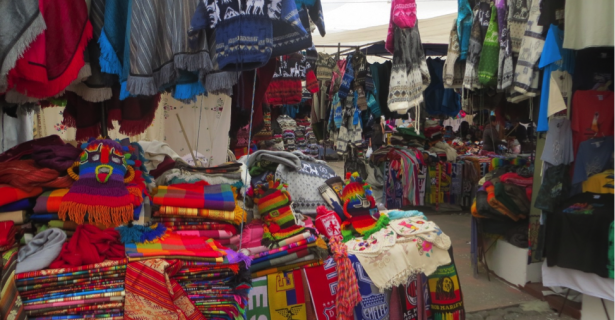Otavalo, our home-base this summer, hosts a world-famous indigenous market. As we continue to work with a company that produces hand-made jewelry, we have begun to uncover the multi-faceted nature of artisan goods.
Several decades ago in northern Ecuador, indigenous Otavaleños were second-class citizens, limited to work as farmers or helpful hands around the house. Despite their reputation as uncannily effective world travelers selling their artisan wares around the world, they were not given the respect they deserved. However, as markets for artisan goods grew in the 1950’s, indigenous Otavaleños earned more and more – financially surpassing their mestizo (non-indigenous) counterparts in Otavalo. As they became recognized as an important economic powerhouse for the region, they were finally able to demand a place at the table – politically, socially, and economically.
With a solid presence on the global market for artisan goods, Otavaleños now share the stage with cheaper manufactured goods. The market has demanded that prices constantly be driven down. Cheaper. More. Faster.
Goods are imported to Ecuador from Peru and Colombia to appease the appetite for alpaca wool blankets, woven tapestries, and Montecristi (Panama) hats. Even designs from indigenous cultures of North America are mixed in, with dream-catchers, head-dresses, and blankets displayed prominently. Products from India and China boast a presence in what is now South America’s largest outdoor artisan market. Given this shift, can the massive market still be considered an “artisan market”?
“It’s made of alpaca wool” will make any meandering shopper pause and reconsider the $25 offer. What one doesn’t quickly realize is that the manufacturer’s label on the inside of the sweater (seen in dozens and dozens of different stalls around the market) will reveal that this mass-produced sweater is “Made in Peru” with only 20% alpaca wool. No one can blame the Otavalo market for responding to demands from its buyers. But this means that artisans who sell their truly hand-made crafts are no longer are in the spotlight; traditional methods of weaving, dyeing, and assembling as well as local designing of goods are dwindling.
The globalization of high-quality artisan goods has enabled countless people to emerge from poverty and claim their rightful seat at the table. But the same unique artistry of goods which caught the world’s attention is being lost as demands for cheaper and more responsive designing steepen. Can a balance be struck so that cultural traditions are preserved while hand-made goods find their place in the global market – being evaluated separately from high-volume plastic products? Or are traditional, hand-made products simply unsustainable on a global scale?
Faire Collection believes such a balance can be struck – artisan goods can be a promising tool to reduce poverty and boost the local economy. By bringing fashion-forward artisan-made accessories to the international market, Faire Collection provides employment for Ecuadorian artisans in need of a needed income source. But only time can tell the effectiveness of these daring business models that are doing their best to manage the tricky relationships between local artisans and their international clients that await the next shipment of “Handmade from Ecuador” to come in.
Benji Moncivaiz and Maya Ranganath, two Fletcher students in between their first and second year, are based in Ecuador interning for the international jewelry business, Faire Collection.


Add new comment